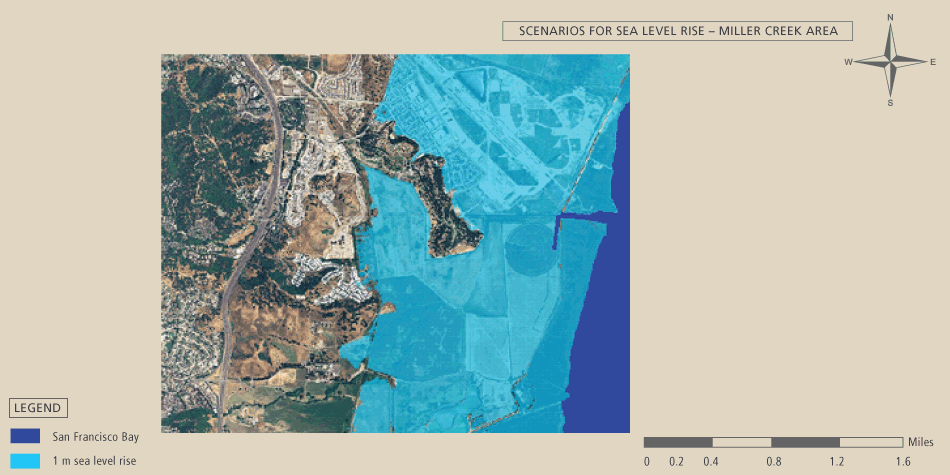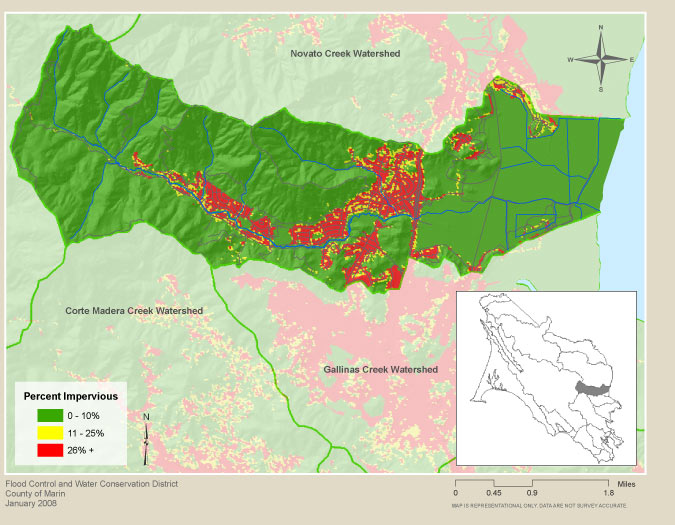
9 The Future

In this section
Overview
There are many possible trajectories of change that will have significant impact on the future of the Miller Creek watershed. Possible changes in climate may result in less frequent, but heavier rains, as well as a rise in sea-level.
A major role of watershed stewards now might be to help the community clarify long-term quantitative ecological and social goals for a sustainable watershed. These goals can be used to plan and prioritize alternative management scenarios. Watershed managers need to identify where changes are needed and set explicit quantitative goals that define success and identify areas for improvement. They need a clear vision for the future of the entire watershed while examining the likely downstream and upstream effects of any management action. Many watershed planners also recognize the need to use monitoring results to adjust the goals for new understanding and changing expectations.
Future planning and restoration efforts within the watershed will need to balance a variety of interests and concerns. These are likely to fit roughly into five major categories:
- Pollution prevention and watershed health evaluations
- Flood risk management
- Evaluation of future watershed design scenarios
- Outreach and education
- Habitat restoration and creation
Reduction of Impervious Surfaces in the Watershed
 |
The history of suburban expansion has increased the area of impervious surfaces in the watershed. Impervious surfaces, such as roads, roofs, and driveways all contribute to additional and faster rainwater runoff in the watershed. This runoff is energizing the stream, causing it to cut deeper into the ground and erode banks. Efforts to mitigate these problems must be carefully managed so as to avoid simply transferring the erosion problem downstream along the hydraulic energy gradient to other parts of the watershed. Homeowners can work to reduce runoff from their property by eliminating direct piped connections of their downspouts to the street gutter and replacing them with splash blocks that allow the water to drain slowly across the property. If space is available, a small pond for rainwater could be built and planted with perennial wetland plants. The impervious contributions from parking lots can be minimized with green spaces between parking rows and driveways can be converted to porous pavement or gravel.
Climate Change and Sea Level Rise
Climate change and sea level rise are especially important sources of uncertainty about future conditions. As the Bay rises, it will tend to move upstream and inland. This will relocate ecological communities associated with the bayland and the tidal reaches of Miller Creek. It will also re-distribute the risk of flooding. The watershed residents might begin to discuss the degree to which they choose to armor the shoreline and hold back the Bay, or give it room to grow. It’s not too soon to start discussing how changing rainfall patterns might affect water supplies for people and wildlife, and how the changes might be accommodated through foresight and planning. A discussion of alternative watershed designs is prudent and appropriate.
Miller Creek Watershed retains important aspects of its natural historical ecology and much of its rural aesthetic. The presence of steelhead in the creek is an important indicator of the relative health of the watershed. Yes, their numbers are decreasing and the creek banks are incised, but if the Miller Creek community can keep the watershed healthy enough to keep the steelhead it will maintain many other ecological services to offer future generations.
